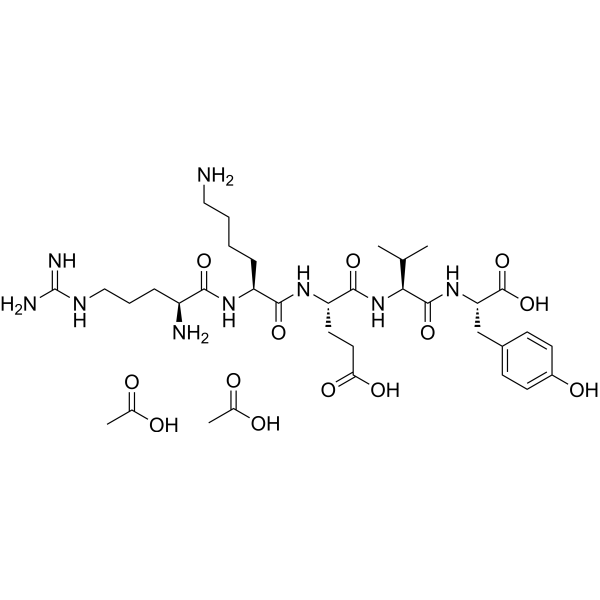
Splenopentin diacetate
CAS No. 105184-37-0
Splenopentin diacetate( Splenopentin Acetate | SP5 | Arg-lys-glu-val-tyr | Splenin pentapeptide (32-36) | Thymopoietin III pentapeptide (32-36) | Splenopentin Acetate | )
Catalog No. M27411 CAS No. 105184-37-0
Splenopentin diacetate is a synthetic immunomodulating peptide and can reproduce the biological activities of splenin and thymic hormone thymopoietin.
Purity : >98% (HPLC)
 COA
COA
 Datasheet
Datasheet
 HNMR
HNMR
 HPLC
HPLC
 MSDS
MSDS
 Handing Instructions
Handing Instructions
| Size | Price / USD | Stock | Quantity |
| 5MG | 45 | Get Quote |


|
| 10MG | 63 | Get Quote |


|
| 25MG | 103 | Get Quote |


|
| 50MG | 150 | Get Quote |


|
| 100MG | 223 | Get Quote |


|
| 500MG | 482 | Get Quote |


|
| 1G | Get Quote | Get Quote |


|
Biological Information
-
Product NameSplenopentin diacetate
-
NoteResearch use only, not for human use.
-
Brief DescriptionSplenopentin diacetate is a synthetic immunomodulating peptide and can reproduce the biological activities of splenin and thymic hormone thymopoietin.
-
DescriptionSplenopentin diacetate is a synthetic immunomodulating peptide and can reproduce the biological activities of splenin and thymic hormone thymopoietin.(In Vitro):Splenopentin diacetate (0.1 ng/mL-10 μg/mL) induces phenotypic differentiation of both T- and B-cell precursor cells, to increase the number of antibody-forming cells in mice after gamma irradiation.(In Vivo):Splenopentin diacetate (0.01-100 μg; i.p.) has no demonstrable effect on neuromuscular transmission of mice. Splenopentin diacetate (1 mg/kg; i.p.) accelerates Langerhans cell recruitment and leads to pretreatment levels of Langerhans cell (LC) density in the skin of female Balb/c/Bln mice were injected Cyclophosphamide or Dexamethasone.
-
In VitroSplenopentin (1-100 μM) augments human NK cells and has no cytotoxicity.Splenopentin (0.1 ng/mL-10 μg/mL; 3 h) induces phenotypic differentiation of both T- and B-cell precursor cells.
-
In VivoSplenopentin (1 mg/kg; i.p. three times a week for 7-90 d) accelerates Langerhans cell recruitment and leads to pretreatment levels of Langerhans cell (LC) density in the skin of mice.Splenopentin (0.01-100 μg per mouse; i.p.) has no demonstrable effect on neuromuscular transmission of mice. Animal Model:Female Balb/c/Bln mice were injected Cyclophosphamide or Dexamethasone for 5 consecutive days Dosage:1 mg/kg Administration: I.p. three times a week for 7-90 days Result:Reached the normal number of epidermal LCs at 28 days after the beginning of Cyclophosphamide treatment.Accelerated restoration process and reached the normal LC density in the skin after 70 days in Dexamethasone treatment grops.
-
SynonymsSplenopentin Acetate | SP5 | Arg-lys-glu-val-tyr | Splenin pentapeptide (32-36) | Thymopoietin III pentapeptide (32-36) | Splenopentin Acetate |
-
PathwayOthers
-
TargetOther Targets
-
Recptor——
-
Research Area——
-
Indication——
Chemical Information
-
CAS Number105184-37-0
-
Formula Weight753.855
-
Molecular FormulaC33H55N9O11
-
Purity>98% (HPLC)
-
Solubility——
-
SMILESCC(O)=O.CC(C)[C@H](NC(=O)[C@H](CCC(O)=O)NC(=O)[C@H](CCCCN)NC(=O)[C@@H](N)CCCNC(N)=N)C(=O)N[C@@H](Cc1ccc(O)cc1)C(O)=O
-
Chemical Name——
Shipping & Storage Information
-
Storage(-20℃)
-
ShippingWith Ice Pack
-
Stability≥ 2 years
Reference
1.Zhu Weifeng, et al. Pesticide composition having synergistic function and application thereof. CN101647434A.
molnova catalog



related products
-
4-Allylpyrocatechol
4-Allylpyrocatechol has antioxidant activity, it has protective activity against the photosensitization-induced damage to lipids and proteins of rat liver mitochondria, which attributes to its free radical and singlet oxygen scavenging properties.
-
Guvacine
Guvacine can enhance the inhibition of spinal neurones by GABA.
-
KS370G
KS370G (Caffeic Acid Phenethyl Amide) inhibits UUO-induced renal fibrosis marker expression.



 Cart
Cart
 sales@molnova.com
sales@molnova.com


